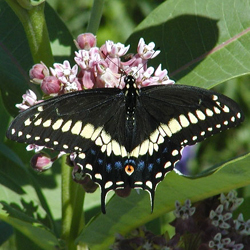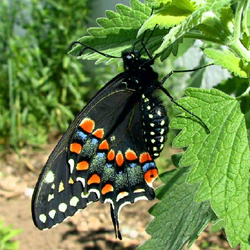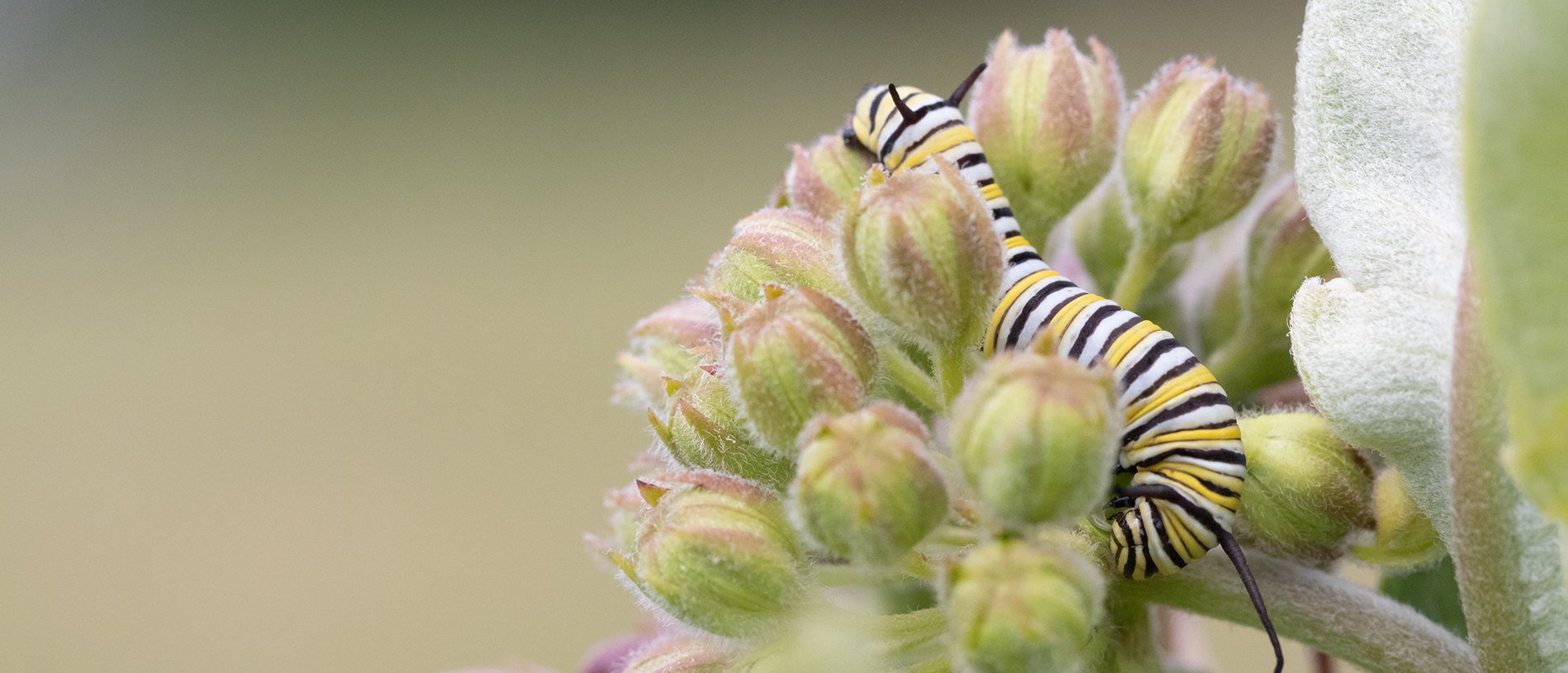Find a Butterfly
Black Swallowtail
Papilio polyxenes
Named
Fabricius, 1775

Taxonomy & Nomenclature
Referred to in some guides as Papilio polyxenes asterius Cramer and/or Eastern Black Swallowtail to distinguish this form from western and southern ones. We follow Opler (1992) with the distribution of polyxenes as described below.
Identification
Wingspan: 2 5/8 - 3 1/2". Both sexes distinguished from all other dark swallowtails of the Northeast by the black center of the prominent orange spot on the inside corner of the hind wing; in all the other dark species this spot is either clear orange or lacking altogether. Male (and some female) Black Swallowtails are readily distinguished from other similar swallowtails by the bold yellow band that parallels the row of marginal yellow spots on both fore and hind wings above.
Most likely to be confused with the other common black swallowtail of the Northeast, Spicebush Swallowtail, but also with Pipevine Swallowtail and the dark female form of Tiger Swallowtail (not in Massachusetts).
Distribution
Throughout the eastern two-thirds of North America from southeastern Saskatchewan to eastern Arizona (mountains) and the Mexican plateau east to Nova Scotia and Florida; tropical forms ranging through Central America to northern South America can also be considered part of this species. Breeds throughout southern New England excepting northern-most Maine.
Status in Massachusetts
Locally common to uncommon throughout the state including the Berkshires and Cape Cod and the Islands. Curiously rare in some areas, e.g. on Cape Ann where Holmes, collecting avidly for ten years, never saw it and Leahy found it only twice during the atlas period (1986-90). Veteran collectors tend to agree that this species was once more common and certainly agricultural fields are far less prevalent here than at any other time in the last century or more. However, its (reported) favorite wild larval food plant, Queen Anne‘s Lace, continues to be an abundant and ubiquitous weed. Maximum: 12, Great Meadows National Wildlife Refuge, Concord (Middlesex Co.), 15 August 1978; 12, Deerfield (Franklin Co.), 8 June 1994; and 12, Windsor (Berkshire Co.), 6 August 1994.

Flight Period in Massachusetts
Two flights, mid-May to early July and mid-July to mid-September. Extreme dates: 14 April 1977, Woburn (Middlesex Co.), R. Robbins; and 23 October 1994, So. Dartmouth (Bristol Co.), J Center.
Larval Food Plants
Members of the carrot family (Umbelliferae) including cultivated species such as carrot, fennel, parsley, celery, and dill on which the large, handsome caterpillar is sometimes a pest; larvae are said to grow faster on cultivated species! Also many wild umbellifers, especially the abundant alien weed Queen Anne‘s Lace (Daucus carota). Other wild New England members of this family on which this species is known to feed include: Great and Hairy Angelicas (Angelica atropurpurea and A. venenosa), Poison Hemlock (Conium maculatum)*, Honewort (Cryptotaenia canadensis), Scotch Lovage (Ligusticum scothicum), Aniseroot (Ozmorhiza longistylus), Wild Parsnip (Pastinaca sativa)*, Mock Bishop‘s Weed (Ptilimnium capillaceum), Caraway (Carum carvi)*, Water Hemlock (Cicuta maculata)*, bulb-bearing Water Hemlock (Cicuta bulbifera)*, Water Parsnip (Sium suave), Yellow Pimpernel (Taenidia integerrima), Hairy-jointed Meadow Parsnip (Thaspium barbinode), and Golden and Heart-leaved Alexanders (Zizia aurea and Z. aptera). The larvae common to these plants and are able to metabolize the powerful toxins contained in such well-known poisonous plants as the water hemlocks. * Alien species.
Adult Food sources
Visits a broad range of flowers over its long season with the usual popular species - milkweeds, clovers and thistles prominent among these. Typically flutters its wings rapidly when nectaring. Newly emergent males may frequent mud puddles.

Habitat
Prefers open habitats such as agricultural fields and gardens, and waste places, mainly upland, but also in open marshes and wet meadows. Frequents wooded trails and shady edges far less than its tree-feeding look-alike, the Spicebush Swallowtail.
Life Cycle
EGG: Yellow to reddish brown, a smooth (granular micro-sculpture) rounded dome; hatching in 7-9 days. OVIPOSITION: Normally eggs are laid singly one to a leaflet on the upper leaf surface; also on flowers bracts (Pavulaan, pers.com.). 206-800 eggs have been counted in the lab LARVA: The mature larva, green with bold black and yellow stripes, is one of the most distinctive North American caterpillars, though details of striping and spotting vary considerably; this stage lasts from 10 days (south) to 4 weeks. CHRYSALIS: Brown or green ; the color variation has been shown to relate to the season in which pupation will occur and the surface on which it takes place, i.e. the chrysalis will tend to be brown in winter and on rough surfaces and green in summer and on smooth surfaces to blend in with the most likely background. PUPATION: As with all swallowtails, the chrysalis is tied vertically to a plant stem, rock, or other vertical surface by a silken girdle and fixed at the lower end with a short adhesive button; pupal stage lasts 8-18 days (usually 10-11) for the summer brood and about 8 months for the overwintering generation. OVERWINTERING STAGE: Chrysalis. According to Lederhouse (1982a), male Black Swallowtails stake out mating areas of about 70 square meters and divide their time between perching (67%), patrolling (25%), feeding (6%) and interacting with other butterflies (2%). Hilltops are preferred mating sites according to some observers. A brief fluttering courtship flight precedes copulation. Females may mate with more than one male.
Account Author
Chris Leahy



